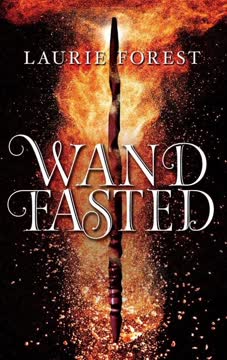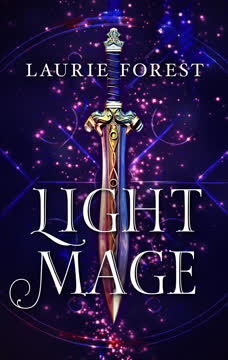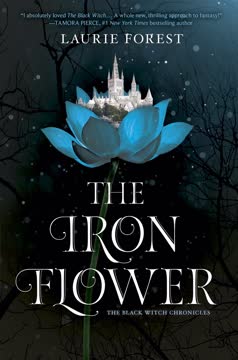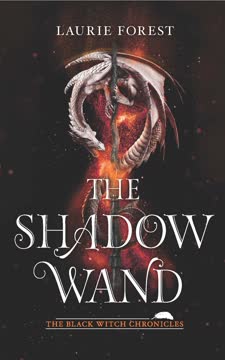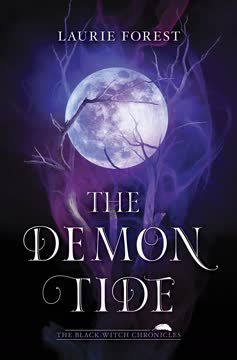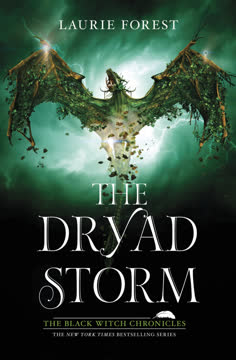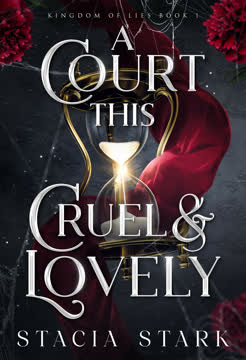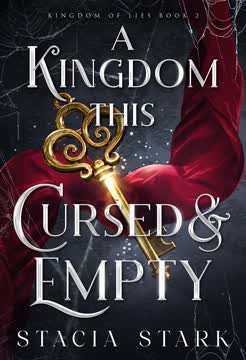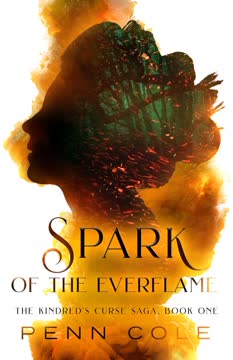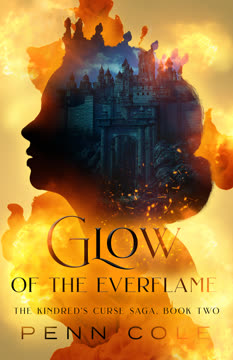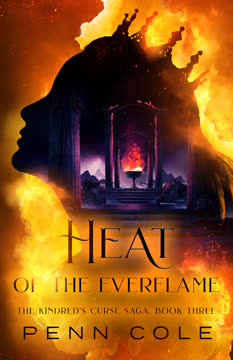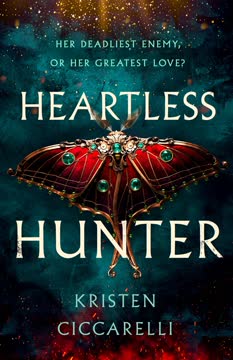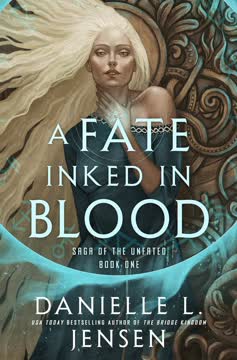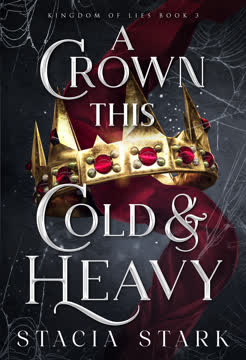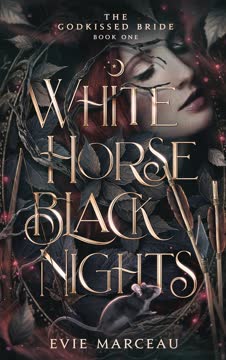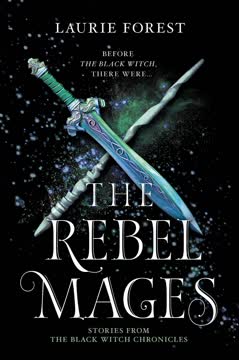Plot Summary
Legacy's Shadow
Elloren Gardner, granddaughter of the legendary Black Witch Carnissa, grows up in a society that reveres magical power and purity above all. Yet, despite her striking resemblance to her grandmother, Elloren is believed to be devoid of magic. Raised in isolation by her gentle uncle, she is shielded from the harsh realities and prejudices of Gardnerian society. When her powerful aunt Vyvian arrives, Elloren's life is upended. Vyvian wants her wandfasted (magically married) to a suitable Mage, but her uncle insists she should pursue her dream of becoming an apothecary at Verpax University. This decision sets Elloren on a path that will force her to confront the darkness and complexity of her heritage, and the expectations that come with it.
Forbidden University
At Verpax University, Elloren is thrust into a melting pot of races and cultures—Gardnerians, Kelts, Elves, Lupines, Urisk, and even Icarals (winged "demons"). The University, meant to be a place of learning and integration, is instead rife with tension, bigotry, and violence. Elloren's lack of magic and her family name make her both a target and a symbol. She is forced to work in the kitchens to pay her tuition, where she faces open hostility from non-Gardnerian students and laborers. Her lodging is with two outcast Icarals, Ariel and Wynter, who initially terrify and despise her. The University becomes a crucible, testing Elloren's beliefs and forcing her to see the world through new eyes.
Prejudice and Power
Gardnerian society is built on strict hierarchies and deep-seated prejudices. Women are expected to be wandfasted young, and "pure" bloodlines are fiercely protected. Non-Gardnerians—especially Urisk, Kelts, and Icarals—are marginalized, abused, or enslaved. Elloren witnesses and experiences this cruelty firsthand: from the caged Selkies sold as pets, to the Urisk children forced into labor, to the banishment and brutalization of those who break social taboos. The myth of Gardnerian moral superiority is revealed as a lie, and Elloren's faith in her people's righteousness is shaken.
Unlikely Friendships
Despite the hostility, Elloren forms unexpected bonds. She befriends Aislinn, a conservative Gardnerian girl with a secret love of poetry; Tierney, a brilliant but ostracized apothecary apprentice hiding her Fae heritage; and Diana and Jarod, Lupine twins who challenge every Gardnerian stereotype. Her relationship with her Icaral roommates evolves from fear to empathy, especially as she learns of their suffering and the lies told about their kind. Most transformative is her growing connection with Yvan, a Keltic kitchen worker with a mysterious past, whose kindness and strength challenge everything she's been taught.
The White Wand's Secret
Early in her journey, Elloren is entrusted with a mysterious white wand by a desperate friend, Sage, who warns her to keep it secret. The wand, rumored to be the legendary White Wand of prophecy, resists all attempts at use—except in moments of crisis, when it channels immense power. Its presence marks Elloren as a figure of destiny, drawing the attention of powerful forces who believe she may be the next Black Witch, prophesied to rise and clash with a great Icaral. The wand's true nature and Elloren's potential become central to the unfolding conflict.
Dress, Deceit, and Rivalry
Aunt Vyvian's efforts to mold Elloren into the perfect Gardnerian lady—complete with fine dresses and a campaign to fasten her to the powerful Lukas Grey—collide with the reality of University life. Elloren's rivalry with Fallon Bane, a prodigiously powerful and cruel Mage, escalates from petty humiliations to dangerous magical attacks. The dressmaker's shop, the Yule dance, and the constant pressure to conform become battlegrounds for identity and agency. Elloren learns to navigate these social minefields, using wit, alliances, and eventually, her own growing sense of self.
The Black Witch's Heir
Elloren's resemblance to her grandmother makes her a living symbol—revered by some, hated by others, and a pawn in political machinations. The Mage Council, led by the zealous Marcus Vogel, sees her as a potential weapon or threat. The Prophecy of a new Black Witch and a great Icaral looms over everything, fueling paranoia and violence. Elloren is repeatedly tested, both by those who want to use her and those who want to destroy her. Her struggle to define herself apart from her bloodline becomes a fight for survival and moral clarity.
Prophecy and Peril
As Vogel rises to power and the Mage Council's policies grow more draconian, the world darkens. Assassins from the East target Fallon Bane, believing her to be the prophesied Black Witch. The University becomes a battleground, with spies, betrayals, and escalating violence. The Prophecy's shadow falls over Elloren, who is increasingly seen as a figure of destiny by both friends and enemies. The threat of war, forced wandfastings, and purges of "impure" bloodlines intensifies, and Elloren must decide where her loyalties truly lie.
Shattered Beliefs
Through forbidden books, conversations with outcasts, and her own experiences, Elloren uncovers the lies at the heart of Gardnerian history. The supposed righteousness of her people is exposed as a myth built on conquest, genocide, and oppression. The fate of the Fae, the truth about the Icarals, and the reality of the Selkie trade force Elloren to question everything she's been taught. Her journey becomes one of unlearning, as she struggles to reconcile her love for her family with the horrors committed in their name.
Allies in the Margins
As the Mage Council's grip tightens, Elloren and her friends—Fae, Lupine, Icaral, Kelt, and sympathetic Gardnerians—form a clandestine alliance. They work together to hide fugitives, rescue the abused, and plot escapes. The North Tower, once a place of fear and isolation, becomes a haven for the marginalized. The group's efforts culminate in the daring rescue of a Selkie and the shattering of a military dragon's cage, acts of open rebellion that mark them as enemies of the state. The lines between friend and foe, right and wrong, become ever more complex.
The Dragon's Cage
The group's most audacious act is the rescue of Naga, an unbroken dragon shifter tortured by the Gardnerians. Using forbidden magic and the combined skills of the outcasts, they shatter the supposedly unbreakable Elfin steel cage. The act unleashes chaos, as hundreds of dragons escape and the military base is destroyed. The consequences are immediate and dire: wanted posters, increased surveillance, and the threat of execution. Yet, the act also cements the group's unity and purpose, proving that resistance is possible, even in the face of overwhelming power.
Camouflage and Resistance
With the Mage Council and Verpacian authorities hunting for the rebels, Elloren and her friends must hide in plain sight. They don white armbands, feign loyalty, and use every means of camouflage to avoid detection. The Vice Chancellor and sympathetic professors reveal themselves as part of a hidden resistance, offering aid and guidance. The cost of resistance is high—fear, betrayal, and the constant threat of exposure—but the bonds forged in adversity grow stronger. Elloren's journey from naive bystander to active rebel is complete.
Breaking Chains
The rescue of the dragon and the Selkie, the protection of Fae and Icarals, and the defiance of unjust laws mark a turning point. Elloren and her allies are no longer just survivors—they are revolutionaries. The act of breaking literal and figurative chains becomes a metaphor for Elloren's own emancipation from the lies and limitations of her upbringing. She embraces her role as a catalyst for change, even as the dangers mount and the future grows more uncertain.
The Cost of Change
The journey is not without cost. Elloren loses her beloved violin, her mother's quilt, and the last vestiges of her innocence. Friends are forced to flee, families are torn apart, and the threat of violence is ever-present. The pain of change is acute, but it is also transformative. Elloren learns that true strength lies not in power or purity, but in compassion, courage, and the willingness to stand with the oppressed.
Revolution's Dawn
As Marcus Vogel consolidates power and the world edges closer to war, Elloren and her friends become the nucleus of a growing resistance. The lines between races, classes, and creeds blur as they fight for a future where justice and freedom are possible. The Prophecy remains unresolved, but Elloren's choices have already begun to reshape the world. The story ends with the promise of revolution—and the knowledge that the fight has only just begun.
The Enemy Within
Elloren's greatest battle is not with external enemies, but with the prejudices and fears she has internalized. Her journey is one of self-confrontation, as she learns to recognize and reject the lies she has been taught. The process is painful and ongoing, but it is also the foundation for true change. By facing the enemy within, Elloren becomes capable of real empathy, solidarity, and leadership.
Love Across Lines
Amidst the darkness, love and friendship offer hope. Elloren's relationships—with Yvan, her brothers, Aislinn, Diana, Tierney, and even her Icaral roommates—become sources of strength and healing. These bonds, forged across lines of race, class, and history, are acts of quiet revolution. The story ends with the promise that, even in a world built on hate, love can be a force for transformation.
Characters
Elloren Gardner
Elloren is the granddaughter of the Black Witch, raised in isolation and believed to be powerless in a society obsessed with magical strength and racial purity. Her journey is one of painful awakening: from naive acceptance of her people's myths to a deep reckoning with the truth of their cruelty. Elloren's greatest strength is her capacity for empathy and change. She is torn between the expectations of her family (especially her manipulative aunt Vyvian), the legacy of her grandmother, and her own growing sense of justice. Her relationships—with outcasts, enemies, and friends—force her to confront her own prejudices and ultimately to choose resistance over complicity. Her development is marked by increasing agency, courage, and a willingness to risk everything for what is right.
Yvan Guriel
Yvan is a Keltic kitchen worker with a secret: he is a powerful Fire Fae in hiding, the son of a Resistance hero. Initially hostile to Elloren, he becomes her closest confidant and the story's emotional center. Yvan's journey is one of survival, secrecy, and reluctant leadership. His kindness, strength, and unwavering sense of justice challenge Elloren's beliefs and inspire her transformation. The slow-burn romance between Yvan and Elloren is fraught with danger, longing, and the hope of a world beyond hate. Yvan's presence psychoanalytically represents the "Other" that must be understood and embraced for healing to occur.
Aunt Vyvian Damon
Vyvian is Elloren's powerful aunt, a member of the Mage Council, and the architect of much of the story's oppression. She is both a mother figure and a threat, using love, guilt, and coercion to control Elloren. Vyvian's psychoanalysis reveals a woman who has internalized the values of her society so deeply that she cannot see their horror. She is both victim and perpetrator, her love for family inseparable from her commitment to Gardnerian supremacy.
Fallon Bane
Fallon is a Level Five Mage, Elloren's chief antagonist at University, and the presumed heir to the Black Witch's legacy. She is brilliant, beautiful, and utterly ruthless, using her power to bully, humiliate, and destroy. Fallon's obsession with Lukas Grey and her rivalry with Elloren are both personal and political. She represents the seductive allure of power without conscience, and her development is a warning of what Elloren could become if she embraces her legacy without question.
Lukas Grey
Lukas is the most eligible Mage at University, desired by both Elloren and Fallon, and the son of the High Commander. He is charming, powerful, and ambitious, but also manipulative and sometimes dangerous. Lukas's relationship with Elloren is marked by attraction, rivalry, and the tension between personal desire and political expediency. He is both a potential partner and a cautionary figure, embodying the complexities of privilege and complicity.
Aislinn Greer
Aislinn is a fellow Gardnerian scholar, raised in a strict, traditional family. Her journey is one of gradual awakening, as her friendship with Elloren and her love for the Lupine Jarod force her to question everything she's been taught. Aislinn's struggle with her own desires, her fear of ostracism, and her longing for freedom mirror Elloren's, and her eventual acts of courage are among the story's most moving.
Tierney Calix
Tierney is a brilliant apothecary apprentice, shunned for her appearance and secret heritage. She is full-blooded Asrai Water Fae, glamoured to appear Gardnerian. Tierney's story is one of survival, shame, and the longing for acceptance. Her friendship with Elloren is transformative for both, and her presence highlights the dangers of purity politics and the necessity of solidarity across lines of difference.
Diana and Jarod Ulrich
Diana and Jarod are wolf-shifters, feared and maligned by Gardnerian society. Diana is brash, fearless, and hilariously blunt; Jarod is sensitive, poetic, and deeply loyal. Their friendship with Elloren and Aislinn challenges the lies told about their people and offers a vision of community beyond prejudice. Diana's budding romance with Rafe (Elloren's brother) and Jarod's love for Aislinn are central to the story's theme of love across boundaries.
Ariel Haven and Wynter Eirllyn
Ariel (Gardnerian) and Wynter (Elfin) are winged "demons" forced to live with Elloren. Initially hostile and traumatized, they become symbols of the cost of scapegoating and the possibility of healing. Ariel's struggle with addiction and self-hatred, and Wynter's gentle empathy, force Elloren to confront the lies at the heart of her culture.
Marcus Vogel
Vogel is the rising power on the Mage Council, a priest whose charisma and ruthlessness make him both a savior and a destroyer in the eyes of his followers. He is the architect of the new purges, forced wandfastings, and the coming war. Vogel's psychological profile is that of the true believer, whose certainty justifies any atrocity. He is the story's most chilling antagonist, representing the danger of ideology unmoored from compassion.
Plot Devices
Prophecy and Inherited Destiny
The narrative is driven by the ancient prophecy of a new Black Witch rising to battle a great Icaral, echoing the past and shaping the present. This device creates tension between free will and destiny, forcing Elloren and others to question whether they are doomed to repeat history or capable of forging a new path. The prophecy is used to justify oppression, violence, and paranoia, but also becomes a source of hope for change.
Parallelism and Mirroring
The story is rich in parallels: Elloren and Fallon as rival heirs; Elloren and Yvan as children of enemies; the treatment of Icarals, Fae, and Selkies as mirrors of Gardnerian oppression. These echoes force characters (and readers) to see the arbitrariness of prejudice and the possibility of transformation. The mirroring of personal and political struggles deepens the narrative's psychological resonance.
The University as Microcosm
Verpax University is a crucible where the world's conflicts are intensified and made personal. The forced proximity of enemies, the pressure to conform, and the constant surveillance create a sense of claustrophobia and urgency. The University's rules, rituals, and hierarchies become battlegrounds for identity, resistance, and change.
Magical Artifacts and Hidden Power
The white wand, the Black Grimoire, and the dragon's cage are more than plot devices—they are metaphors for hidden potential, forbidden knowledge, and the possibility of liberation. The struggle to control or destroy these objects reflects the larger battle over who gets to define truth, power, and destiny.
Camouflage, Code-Switching, and Subterfuge
Characters must constantly hide their true selves—through dress, language, and behavior—to survive in a hostile world. This device highlights the psychological toll of oppression and the creativity required to resist it. The use of camouflage (literal and figurative) becomes a form of resistance and a means of building solidarity among the marginalized.
Shifting Narratives and Unreliable History
The story repeatedly challenges the "official" history of Gardneria, revealing it as a tool of power and control. Forbidden books, oral histories, and the lived experiences of outcasts offer alternative truths. This device forces both characters and readers to question what they have been taught and to seek justice in the face of lies.
Analysis
Laurie Forest's The Black Witch is a sweeping, psychologically rich fantasy that interrogates the roots of prejudice, the seduction of power, and the possibility of change. Through Elloren's journey from sheltered innocence to active resistance, the novel explores how systems of oppression are built, maintained, and—crucially—challenged. The story's greatest strength lies in its refusal to offer easy answers: every character is shaped by their history, trauma, and the lies they have been told, and every act of rebellion comes at a cost. The book is a meditation on the dangers of inherited hate, the necessity of unlearning, and the courage required to stand with the marginalized. Its lessons are urgent and timely: that true strength lies not in purity or power, but in empathy, solidarity, and the willingness to risk everything for justice. In a world where the lines between good and evil are blurred, The Black Witch insists that another future is possible—if we have the courage to choose it.
Last updated:
FAQ
Synopsis & Basic Details
What is The Black Witch about?
- A Journey of Unlearning: The Black Witch follows Elloren Gardner, granddaughter of a legendary Mage, as she navigates a world steeped in prejudice and magical hierarchy. Believed to be powerless, Elloren is sent to Verpax University, a melting pot of diverse races, where her sheltered worldview is shattered by the realities of systemic oppression and the discovery of her own complex heritage.
- Confronting a Dark Legacy: The narrative delves into Elloren's struggle to reconcile her family's revered past with the brutal truths of Gardnerian history, which is built on conquest and the subjugation of other races. She grapples with the expectations tied to her grandmother's powerful, yet violent, legacy as "The Black Witch," while forming unlikely alliances with those her society has taught her to hate.
- Rising to Resistance: As a zealous new High Mage rises to power, threatening war and purges, Elloren finds herself at the heart of a burgeoning resistance movement. She must choose between conforming to her society's oppressive norms or risking everything to fight for justice and protect her newfound friends, ultimately discovering her own strength and purpose beyond the confines of her inherited destiny.
Why should I read The Black Witch?
- Deep Dive into Prejudice: The novel offers a profound exploration of prejudice, racism, and systemic oppression, forcing readers to confront uncomfortable truths about how societies construct "otherness" and justify cruelty. It's a powerful narrative for understanding the insidious nature of inherited hate and the courage required to dismantle it.
- Complex Moral Landscape: Readers will appreciate the nuanced moral dilemmas presented, where characters are rarely purely good or evil, but products of their environments and histories. Elloren's journey of unlearning and her struggle to define her own moral compass in a world of blurred lines provides rich ground for reflection and discussion.
- Rich World-Building & Character Arcs: Beyond its thematic depth, the book boasts intricate world-building with diverse races, unique magic systems, and a compelling cast of characters. Elloren's transformative arc, from naive and sheltered to empathetic and rebellious, is particularly engaging, offering a satisfying journey of self-discovery and empowerment.
What is the background of The Black Witch?
- A History of Conquest and Myth: The world of The Black Witch is shaped by a long history of inter-racial warfare, with the Gardnerians, led by powerful Mages like Elloren's grandmother, having risen to dominance through brutal conquest. This history is enshrined in their holy text, The Book of the Ancients, which paints Gardnerians as "First Children" and other races as "Evil Ones," justifying their oppression.
- Political and Social Hierarchy: Gardnerian society is rigidly hierarchical, valuing magical power and "pure" bloodlines above all else. Women are largely subservient, expected to be wandfasted young, while non-Gardnerian races like Kelts, Urisk, Elves, and Icarals face varying degrees of marginalization, enslavement, or outright persecution. The Mage Council, a powerful governing body, enforces these norms.
- Verpax University as a Crossroads: The story is primarily set at Verpax University, a unique institution in the neutral country of Verpacia. While ostensibly a place of learning and integration for all races, it serves as a microcosm of the wider world's conflicts, prejudices, and political tensions, making it a dangerous yet transformative environment for Elloren.
What are the most memorable quotes in The Black Witch?
- "Dominate, or be dominated. Those are your choices.": Lukas Grey's stark philosophy, delivered to Elloren, encapsulates the brutal power dynamics of their world and the difficult choices characters face. This quote highlights the central theme of survival and the moral compromises demanded by a society built on oppression.
- "Real education doesn't make your life easy. It complicates things and makes everything messy and disturbing. But the alternative, Elloren Gardner, is to live your life based on injustice and lies.": Professor Kristian's profound statement to Elloren defines the core of her journey. It underscores the novel's exploration of truth, critical thinking, and the painful but necessary process of unlearning ingrained prejudices.
- "I'm beginning to think it's all hogwash anyway... All this stuff about Evil Ones. But that doesn't change the fact that everyone else seems to believe it.": Elloren's internal reflection to Trystan marks a pivotal moment in her ideological shift. This quote reveals her growing disillusionment with Gardnerian dogma and her dawning understanding of how deeply entrenched prejudice is, even when its foundations are false.
What writing style, narrative choices, and literary techniques does Laurie Forest use?
- First-Person Limited Perspective: The novel is told entirely from Elloren's perspective, immersing readers directly into her internal struggles, evolving perceptions, and emotional reactions. This narrative choice effectively highlights her journey of unlearning and allows for a gradual unveiling of the world's harsh realities as she experiences them.
- Symbolism and Imagery: Forest heavily employs symbolism, particularly with natural elements like trees, colors (black, white, green), and animals (dragons, wolves, seals, birds). The recurring imagery of "blackness" (Elloren's hair, Gardnerian garb, the Black Witch legacy) contrasts with "whiteness" (the White Wand, Elves, Watchers), creating a visual language that underscores themes of good, evil, purity, and corruption.
- Foreshadowing and Dramatic Irony: Subtle hints and seemingly minor details often foreshadow major plot developments or character revelations, building suspense and rewarding attentive readers. Dramatic irony is frequently used, especially in Elloren's initial naivety about her society's true nature, allowing readers to grasp truths before she does, intensifying the impact of her eventual realizations.
Hidden Details & Subtle Connections
What are some minor details that add significant meaning?
- The Significance of Wood: Elloren's innate connection to wood, her ability to "feel" a tree's history and essence, is a subtle but crucial detail. This "nature fixation" (Chapter 1) is initially dismissed as a strange quirk or a sign of "Fae blood" by her uncle, but it foreshadows her deeper, untamed magical affinity, distinct from traditional wand magic, and links her to the ancient, natural world rather than rigid Gardnerian structures.
- The Urisk Child's Bubble Wand: Little Fern's bubble wand, made by Yvan (Chapter 5, Chapter 18), is a small, poignant detail. It symbolizes Yvan's hidden kindness and his connection to the marginalized, contrasting sharply with the Gardnerian perception of Urisk as "savages." This simple toy highlights the innocence of children and the arbitrary nature of prejudice, revealing Yvan's true character long before his full identity is known.
- Fallon's Rune-Marked Uniform: The sudden appearance of glowing runes on Fallon's uniform during the assassin attack (Chapter 21) is a blink-and-you-miss-it detail. It reveals that her clothing was secretly "rune-marked with search runes" by the military, allowing her to be tracked. This detail subtly exposes the Mage Council's pervasive surveillance and control, even over their own powerful Mages, hinting at a deeper, more insidious level of manipulation within Gardnerian society.
What are some subtle foreshadowing and callbacks?
- The Prologue's Fire Dream: Elloren's childhood memory of fire shooting from a stick and engulfing the forest (Prologue) is a powerful piece of foreshadowing. Initially dismissed as a dream, it hints at her latent, destructive fire magic and the traumatic origin of her suppressed powers, directly linking to her later discovery of her affinity for fire and her role in the dragon escape.
- Gareth's "Less-Than-Pure Blood": Gareth's silver-highlighted black hair (Chapter 1) is noted as a sign of "less-than-pure blood," leading to teasing. This detail subtly foreshadows the later revelation of widespread Fae blood among Gardnerians, including Elloren herself, and the arbitrary nature of racial purity claims, setting up the theme of hidden heritage and the dangers of "iron-testing."
- The Watchers' Silent Guidance: The recurring appearances of the white "Watcher" birds (Chapter 2, 4, 5, 10, 18, 21, 23, 26) are consistently subtle. They appear at pivotal moments, often when Elloren is in danger or needs to discover a truth, guiding her to Sage, to the Selkie, and even to Yvan's cottage. Their silent presence acts as a mystical, benevolent force, hinting at a deeper, unseen order at play, contrasting with the overt magical displays of Mages.
What are some unexpected character connections?
- Professor Hawkkyn and Professor Kristian's Friendship: The revelation that the Snake Elf Professor Hawkkyn and the Keltic Professor Kristian are "good friends" (Chapter 6, Part 2) is unexpected given the historical animosity between their races. This connection subtly highlights the existence of inter-racial solidarity and intellectual exchange beneath the surface of societal prejudice, offering a quiet counter-narrative to the dominant themes of conflict.
- Vice Chancellor Quillen's Hidden Role: Vice Chancellor Lucretia Quillen, initially appearing as a stern enforcer of University rules, is unexpectedly revealed to be a key figure in the Resistance, having hidden "two hundred and fifty-six" Fae children during the war (Chapter 25, Part 2). Her adopted Sylphan Fae daughter, Zephyr, and her brother Fain, who keeps "pit dragons" as companions, further deepen her unexpected connection to the marginalized and the Resistance, subverting her initial portrayal.
- Ariel's Nilantyr Addiction: The discovery that Ariel's aggressive behavior stems from a forced nilantyr addiction, administered during her childhood imprisonment in the Valgard asylum (Chapter 23, Part 2), creates an unexpected layer of empathy for her. This detail transforms her from a "demonic" antagonist into a victim of Gardnerian cruelty, forging a deeper, more complex connection with Elloren and challenging Elloren's initial judgment.
Who are the most significant supporting characters?
- Uncle Edwin: Elloren's adoptive uncle, Edwin, is a quiet, violin-making Gardnerian who raised Elloren and her brothers. His "dangerously naive" (Chapter 14) nature and aversion to violence, coupled with his secret teaching of violin-making to Elloren (forbidden for women), subtly shape Elloren's early moral compass and her later questioning of Gardnerian norms. His illness becomes a catalyst for Elloren's forced independence and her aunt's manipulative interventions.
- Priest Simitri: Elloren's History and Botanicals professor, Priest Simitri, initially appears as a kind, paternal figure who reveres Elloren's grandmother. However, his unwavering support for Vogel and his biased teaching of Gardnerian history (Chapter 13, Chapter 26, Part 2) serve as a crucial foil to Professor Kristian's teachings, highlighting the pervasive nature of propaganda and the difficulty of discerning truth within a dominant narrative.
- Olilly: The shy, lavender-skinned Urisk kitchen worker, Olilly, is a minor character whose vulnerability and fear of Gardnerians (Chapter 19, Chapter 27, Part 2) serve as a stark reminder of the systemic oppression faced by her people. Her quiet act of kindness in offering Elloren salve for her burn (Chapter 1, Part 3) and her later rescue by Yvan underscore the themes of empathy and inter-racial solidarity.
Psychological, Emotional, & Relational Analysis
What are some unspoken motivations of the characters?
- Aunt Vyvian's Legacy Obsession: Aunt Vyvian's relentless drive to see Elloren wandfasted to Lukas Grey and groomed for a position on the Mage Council (Chapter 1, 2, 13) is not solely for Elloren's benefit. Her unspoken motivation is to reclaim the "Black Witch" legacy for her own family line, believing that such power "rightfully belongs in our line" (Chapter 6). This reveals a deep-seated ambition and a desire to control the narrative of her powerful mother's heritage, projecting her own unfulfilled desires onto Elloren.
- Lukas Grey's Strategic Courtship: Lukas's immediate and persistent pursuit of Elloren, despite her initial rejection and lack of magic, is driven by more than simple attraction. His unspoken motivation is strategic: to secure a powerful alliance with the granddaughter of the Black Witch, a figure of immense symbolic importance, especially as Vogel rises to power (Chapter 12, 14). His candor about his lack of religious belief (Chapter 8) suggests a pragmatic, rather than ideological, approach to power, making his interest in Elloren a calculated move for influence.
- Yvan Guriel's Protective Instincts: Yvan's initial hostility towards Elloren, followed by his gradual softening and fierce protectiveness (Chapter 5, 8, 21, 27, Part 2), is rooted in a deep, unspoken trauma. His father was killed by Carnissa Gardner (Chapter 15, Part 2), making Elloren's resemblance a painful trigger. His motivation to protect her, despite his personal history, stems from his inherent sense of justice and his recognition of her true character, revealing a profound capacity for empathy that transcends inherited hatred.
What psychological complexities do the characters exhibit?
- Elloren's Internalized Prejudice and Cognitive Dissonance: Elloren exhibits significant psychological complexity as she grapples with the cognitive dissonance between her ingrained Gardnerian beliefs and the harsh realities she witnesses. Her initial fear of Icarals and Kelts, even after experiencing their kindness, shows how deeply internalized prejudice can be. Her struggle to reconcile her love for her family with the atrocities committed in their name (Chapter 26, Part 2) highlights the psychological toll of confronting one's own complicity and the painful process of moral awakening.
- Ariel's Trauma-Induced Aggression and Vulnerability: Ariel's character is a complex study of trauma. Her aggressive, hostile outbursts and destructive tendencies (Chapter 6, 10, 18) are revealed to be a coping mechanism for the profound abuse and nilantyr addiction she suffered as a child (Chapter 23, Part 2). Beneath her rage lies a deep vulnerability, particularly evident in her tender care for animals and her dependence on Wynter, showcasing the psychological scars of systemic cruelty and the desperate need for connection.
- Tierney's Glamoured Identity and Fear of Exposure: Tierney's "crooked back" and "unpleasant appearance" (Chapter 15) are physical manifestations of a Fae glamour designed to protect her from persecution. Her psychological complexity lies in the constant fear of exposure and the shame associated with her true identity (Chapter 20, Part 2). Her sardonic humor and guarded nature are defense mechanisms, revealing the immense psychological burden of living a hidden life and the profound impact of societal prejudice on self-perception.
What are the major emotional turning points?
- The Selkie's Screaming Plea: Elloren's encounter with the caged Selkie in Valgard (Chapter 5) is a major emotional turning point. The Selkie's "wild terror" and "earsplitting croak" for help deeply disturb Elloren, planting the first seeds of doubt about her aunt's casual cruelty and the righteousness of Gardnerian society. This moment marks the beginning of Elloren's empathy for the "other" and foreshadows her later acts of defiance.
- Ariel's Kindred's Death: The brutal killing of Ariel's chicken, her "kindred," orchestrated by Lukas (Chapter 21, Part 2), is a devastating emotional turning point for Elloren. Witnessing Ariel's raw grief and Wynter's empathic pain forces Elloren to confront the true cost of her desire for revenge and the moral compromises she's willing to make. This event shatters her trust in Lukas and solidifies her commitment to protecting the marginalized, regardless of their race.
- Yvan's Healing of Fern: Yvan's miraculous healing of little Fern's broken leg (Chapter 18, Part 3) is a powerful emotional turning point, particularly for Elloren. It reveals Yvan's hidden Fae nature and his profound capacity for compassion, directly contradicting Gardnerian propaganda about Kelts and Fae. This act of healing, witnessed by Elloren, deepens her trust in Yvan and reinforces her growing belief in the inherent goodness of those deemed "evil."
How do relationship dynamics evolve?
- Elloren and Aunt Vyvian: From Admiration to Defiance: Elloren's relationship with Aunt Vyvian evolves from initial admiration and a longing for maternal guidance (Chapter 2) to growing suspicion and outright defiance. Vyvian's manipulative tactics, her threats regarding Elloren's future, and her casual cruelty towards other races (Chapter 13, Chapter 10, Part 3) gradually erode Elloren's respect, culminating in Elloren's rejection of Vyvian's plans and her embrace of the Resistance.
- Elloren and Yvan: From Hostility to Deep Connection: The dynamic between Elloren and Yvan undergoes a profound transformation, starting with mutual hostility and prejudice (Chapter 5, 12). Their shared experiences in the kitchen, Yvan's unexpected defense of Elloren (Chapter 1, Part 3), and Elloren's growing understanding of his hidden kindness gradually break down barriers. Their relationship evolves into a deep, unspoken connection, marked by mutual respect, trust, and a burgeoning romantic tension that defies societal norms (Chapter 15, Part 3).
- Elloren and Her Roommates: From Fear to Found Family: Elloren's relationships with Ariel, Wynter, and Diana transform from initial fear and animosity to a complex, supportive "found family" dynamic. Her initial terror of Ariel and Wynter (Chapter 5, 6) gives way to empathy as she learns their stories. Diana's arrival, initially disruptive, solidifies the group's bond, creating a haven of mutual protection and understanding in the North Tower, where they collectively defy societal expectations and prejudices (Chapter 7, 11, Part 3).
Interpretation & Debate
Which parts of the story remain ambiguous or open-ended?
- The White Wand's True Nature and Elloren's Power: While the white wand is established as powerful and responsive to Elloren, its full capabilities and its connection to the ancient "White Wand of legend" remain somewhat ambiguous. Elloren's own magical potential, though sensed by Lukas and hinted at by her connection to wood, is never fully realized or explained by the end of the book. This leaves readers to ponder the extent of her latent power and how it might manifest in future installments, fueling The Black Witch analysis and Elloren Gardner power explained discussions.
- The Fate of Sage's Icaral Baby: The ultimate fate of Sage Gaffney's Icaral baby, the "Icaral of Prophecy," is left unresolved. While the Gardnerians are actively hunting for him, and the prophecy foretells a clash with the Black Witch, the baby's whereabouts and future role in the unfolding conflict remain open-ended. This ambiguity creates suspense and allows for reader speculation about the prophecy's true meaning and the baby's potential for good or evil, a key point for The Black Witch prophecy explained searches.
- The Long-Term Impact of the Resistance: The novel concludes with the Resistance gaining momentum and forming unexpected alliances, but the ultimate success or failure of their efforts against the powerful Gardnerian Mage Council and Marcus Vogel remains uncertain. The "revolution's dawn" is just beginning, leaving the future of Erthia and the fate of its diverse peoples open to interpretation, inviting readers to debate the efficacy and long-term consequences of their rebellion.
What are some debatable, controversial scenes or moments in The Black Witch?
- Lukas's Orchestration of Ariel's Kindred's Death: Lukas's deliberate killing of Ariel's chicken, her "kindred," to provoke Ariel into attacking Elloren (Chapter 21, Part 2) is a highly controversial moment. While intended to help Elloren escape her lodging situation, it is a cruel and manipulative act that raises questions about Lukas's morality and the "ends justify the means" philosophy. This scene sparks debate about whether Elloren's complicity in the act is forgivable and the ethical boundaries of resistance.
- The Portrayal of Gardnerian Religious Beliefs: The depiction of Gardnerian religious
Review Summary
The Black Witch has generated significant controversy, with some readers praising its exploration of prejudice and character growth, while others condemn it for racist and offensive content. Supporters argue the book effectively portrays the challenges of overcoming ingrained biases, while critics claim it perpetuates harmful stereotypes. Many reviewers emphasize the importance of reading the book before forming an opinion. The novel's world-building and character development receive praise, though some find the pacing slow. Despite the polarizing reception, numerous readers express eagerness for the sequel.
The Black Witch Chronicles Series
Similar Books
Download PDF
Download EPUB
.epub digital book format is ideal for reading ebooks on phones, tablets, and e-readers.

